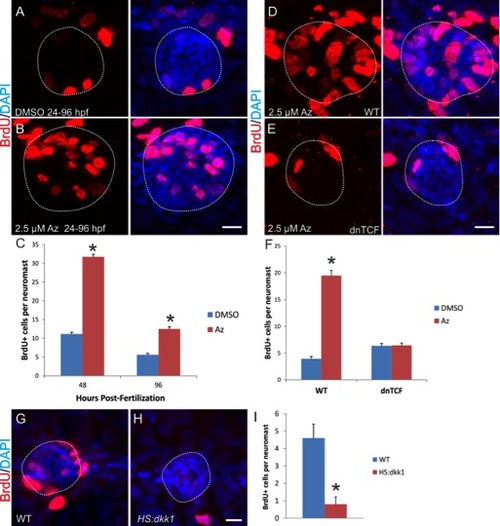Fig. 4
- ID
- ZDB-FIG-130726-30
- Publication
- Head et al., 2013 - Activation of canonical Wnt/beta-catenin signaling stimulates proliferation in neuromasts in the zebrafish posterior lateral line
- Other Figures
- All Figure Page
- Back to All Figure Page
|
Az stimulates a persistent increase in proliferation of lateral line progenitors dependent on the canonical Wnt signaling pathway. A–C: Zebrafish were treated with DMSO or 2.5 μM Az beginning at 24 hpf, then given a 10-min pulse label of BrdU either at 48 or 96 hpf with fixation following 2 hr after BrdU-labeling. Images show BrdU labeling (red) or BrdU overlaid on DAPI (blue) labeling all nuclei. Dashed lines represent the extent of the neuromast. A: DMSO-treated zebrafish labeled with BrdU at 96 hpf show few dividing supporting cells. B: Az-treated zebrafish labeled with BrdU at 96 hpf show supporting cells throughout the neuromast labeled with BrdU. C: Quantification of the number of BrdU-positive cells in two anterior neuromasts from each of 7 fish treated with BrdU at either 48 or 96 hpf and fixed 2 hr later. Az stimulates more than twice as many dividing cells as DMSO-treated controls at both time-points (*P < 0.001). D–F: Inhibition of the canonical Wnt/β-catenin signaling pathways by heat-shock induction of dominant-negative TCF3 at 48 hpf suppresses the Az-induced increase in the number of proliferating progenitors at 72 hpf. Wild-type siblings that do not express the dominant negative transgene show the significant increase in the number of BrdU+ cells at 72 hpf induced by Az (D,F), but this increase is completely suppressed in fish expressing the transgene (E,F; *P < 0.001). G–I: Inhibition of supporting cell proliferation by the dkk1 transgene. Following heat shock, wildtype fish show normal levels of proliferation (G,I), but transgenic siblings expressing the dkk1 transgene have largely suppressed the proliferation of their supporting cells (H,I; *P < 0.001; t-test). Scale bars: B, E, H = 10 μm. |

